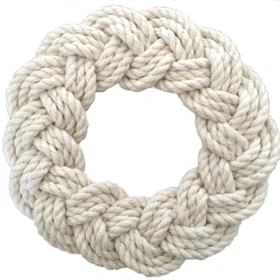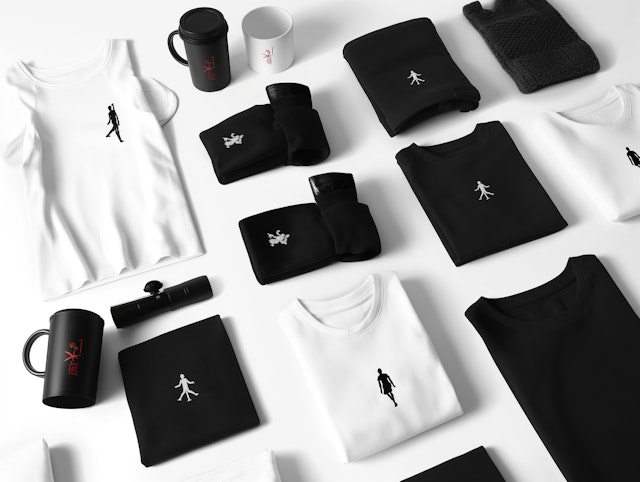How WhatKnotShop got started
Introduce your Etsy shop and tell us your story. How did you begin and decide on what to sell on Etsy, and how do you create your products?
My name is George Hutchinson and I grew up on the east coast in a family of four sibs, with a stay-at-home mom and a work-in-town dad. My grandfather had a large house on the seashore in Rhode Island during the summers, where we lived. I spent a lot of time on and around boats with my dad, sailing the coast of New England and Long Island. During this time, I learned how to make the basic three-part braided rope bracelets that were ubiquitous on the New England coast. After college, I moved to Minneapolis and went to grad school in architecture, then worked for several small design firms before joining a large, well-known retail corporation. Many years (and mortgage payments) later, I was outsourced along with several hundred of my former colleagues.
I started WhatKnotShop on ETSY (and two other platforms) as a necessary diversion from the cramped cooker of corporate culture. At first I offered just a few basic designs, but soon started listing more experimental and complex knotted bracelets ("What is that knot called anyway?") This was 2008, and online retail was just beginning to gain credibility. I was making things that were easy for me to make with low-cost materials. I was also playing around with other design ideas having no apparent marketability whatsoever. I was using the three online shops (Artfire, Zibbett, and ETSY) as experimental creative outlets, not expecting to generate great profits. Sales volumes were very low.
I used my design school experience to develop the product photography, the color systems, the inventory management system, and other solutions for the shop. I started buying bulk cord from another small online vendor. He recently sold his wholesale business to a company in Ohio, but the cotton cord is still coming from the same mill in North Carolina. I also use a variety of synthetic cord materials to make variations of the braided designs, which are slightly more durable than the cotton. These come from a variety of online businesses.
When you visit the shop, you will also find a group of highly unusual designs that are made with cord scraps and beads. These free-form organic creations are pure flights of fantasy.
All the products you see in the shop are handmade one at a time using traditional techniques. I hand dye the cord in small batches using a water-based dye system. I keep a database of dye formulas for reference, but the natural variations in color are a feature of the product. No two are ever exactly the same.
Favorite items
What are your favorite items? What makes these so special? Why do you think these items might be selling well?
My favorites are not the best sellers... I like making free-form layered designs that have a distinctly organic feel like these:
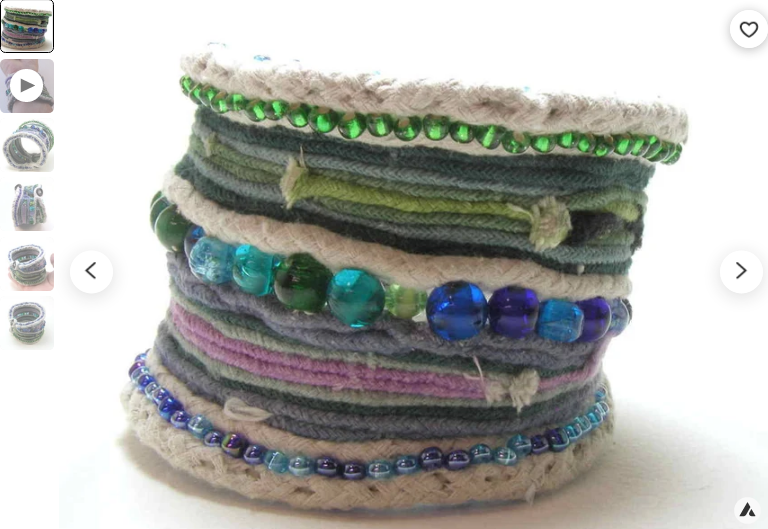
Or this:
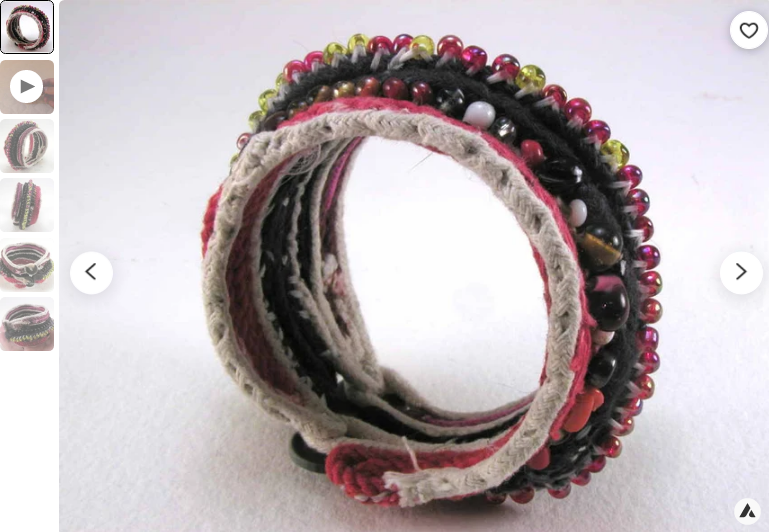
These are fantasy constructions that take a while to build but have whimsical elements that transcend the more traditional braided designs. I also like the complexity of the multi-part knots that are represented by this listing:
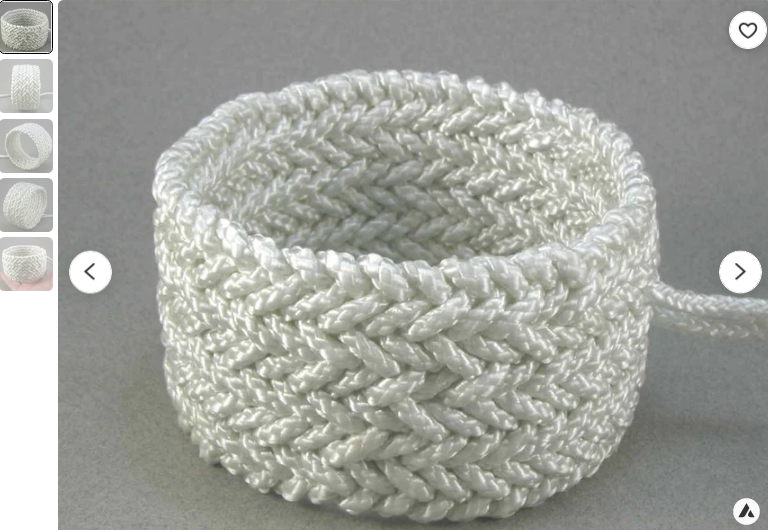
This is made from a single piece of cord. Laying out this knot on a circular form and working it up to a finished condition takes time, but the result is impressive.
Then there are these interwoven cuffs:
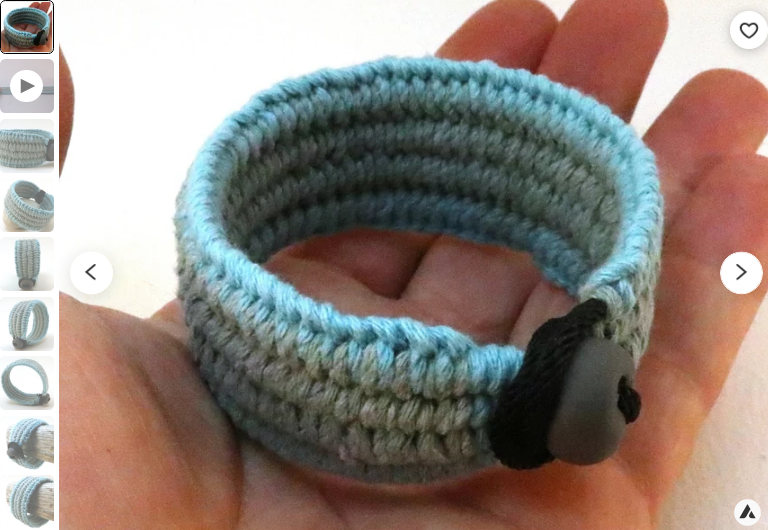
These are constructed on a set of core cords stretched out on a small loom. The weft is a dyed string that is passed through the warp cords and then a second layer of complementary color is added to the original weave, creating the optical blended color effects.
A more traditional and somewhat popular design is this adjustable slip-knot rope bracelet:
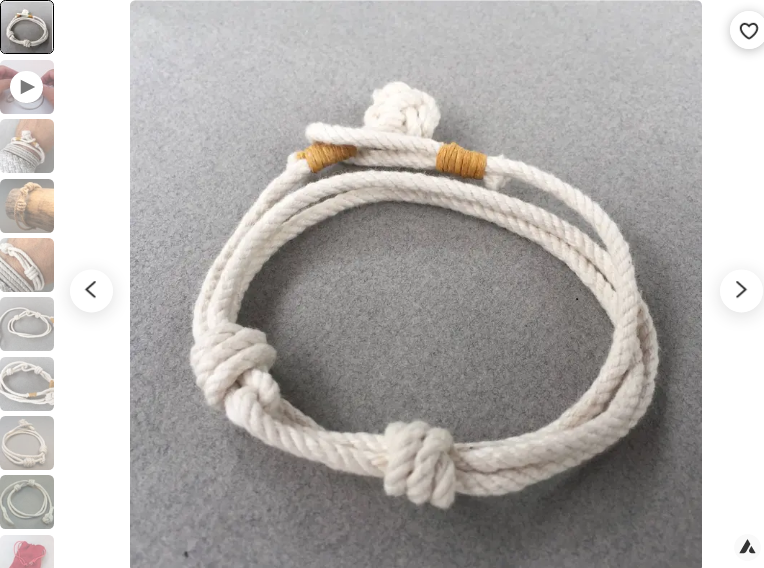
These are a unique design that I developed which allows the size of the bracelet to be expanded to fit over the hand and then adjusted to the smaller wrist size. The problem with many adjustable rope bracelet designs is the loose ends. This design uses a loop and ball knot toggle to keep the ends from flapping around once the final size adjustment is made.
The traditional braided designs are the most popular with buyers. I ship worldwide, including Europe and Australia.
Getting sales on Etsy
How long did it take for you to earn your first sale and how do you currently attract customers to your Etsy shop?
I opened several online shops in 2008, including venues on Artfire, Zibbett, and ETSY. I also started a blog with images and links to these shops. The blog is here :https://whatknotnow.blogspot.com/
I posted products and a series of how-to tutorials, and most, but not all, are still available for reference. The most important function of the blog is a posting that offers advice for buyers on size selection. The current ETSY site structure does not support an informational resource like this, so this posting remains an important sales tool.
https://whatknotnow.blogspot.com/2009/10/figuring-fit-how-to-pick-size-thats.html
Initially sales were very slow to come. I think it was about a month before a single sale was registered, and the first year was about 1 sale per week, sometimes less. The online sales tools at that time were crude and difficult to operate. Shipping was particularly troublesome, with packages and postage in a constant state of confusion. For the first few years, there were a handful of sales on each of these three platforms. Gradually, the Artfire and Zibbett platforms withered away until they both disappeared a few years ago. By 2010, I had a total of $3912 in total sales, $1690 in costs, and a net profit of $2222. Typically, July is the big sales month, while January is the slowest. This pattern has remained more or less consistent with occasional bulk orders.
The primary promotional tools were the Google blog, a few chat rooms, and not much else. There were a few repeat customers and a few referrals. Most recently (2021), sales were $30,020, net profit $16290. Promotion relies mainly on ETSY ads, but there is a legacy of Google blog postings, some limited Twitter activity, and some Pinterest work that feeds into the current sales profile. I post images and videos to Pinterest occasionally.
Recently, I started a second shop named ArtiFactSite that came online a couple of years ago and that is beginning to contribute to sales volume. This shop turns ordinary contemporary materials into things that are inspired by the expressions of heritage cultures.
https://www.etsy.com/shop/ArtifactSite
Most of these items are made in my shop which is a newly constructed solar powered place where the tools and projects take priority over car storage. (Some would call this building a garage…)
Managing WhatKnotShop
How do you manage your shop? Are you running solo or do you have any team members? What tools or services do you use to run your shop and how do you handle fulfillment?
It’s a one-person operation (me)… Shop management follows a daily routine and also has longer cycles. The daily routine involves reviewing the notices each morning to see if there are sales orders to fill; checking the activity feed to see which items are gaining attention; and looking at the expired listings. I keep a select few of the more popular items in inventory so that they may be packaged and shipped immediately. Some items are made-to-order using a predefined recipe, and some orders are custom-built and require extra time to assemble. I use the ETSY web interface on a desktop mac to handle shop management and fulfillment. I use the phone apps to communicate with buyers primarily.
Fulfilling orders usually requires a few minutes to print the packing slips, locate items in inventory (I use a serial number based system with stacked boxes to store everything,) Print shipping labels and stuff envelopes. I keep a limited number of cardboard shipping boxes on hand for bulky items like the display stands. Most days, the mail carrier picks up the small packages right from my front door. When I have more than four packages or larger boxes, I run them down to my local post office and drop them off.
The items are created in one of three ways: high volume products, such as the three-part braided bracelets, are created in groups, usually in the evenings while watching British detective dramas on TV. The colored items are made from dyed cord, prepared in batches and stored in a big display rack. I have a "cheat sheet" of specifications that I keep handy for looking up cord lengths and other details. Made-to-order items are also made overnight from my inventory of materials. Custom work usually requires more time and may involve messaging with the buyers to confirm details. During busy sales periods, the production time may extend to two or three days.
The listings depend mainly on photography that I do in a bed sheet light box in my basement. I use a Canon digital camera and an iPhone. I transfer the images to a cloud storage system and edit the images using Graphic Converter. Videos are done using the iPhone and iMovie to assemble and edit the clips. Listing descriptions in the shop follow a rubric that includes a short descriptive intro, details about size, and footnotes. As the ETSY system has developed over time, the listings have needed updates to attributes, shipping parameters, and other bits that ETSY sees fit to foist upon us from time to time.
Sometimes new products are simply variations of existing designs (multiple colors, etc.), and sometimes they are completely new ideas inspired by online research, browsing social media feeds, or other off-the-wall inspirations. Keeping lots of "stuff" around the studio leads to a creative form of play that sometimes results in new products. Much of the shop's inventory is these ideas. These may have low sales volume but are important visualizations and explorations. The higher volume products are what fund the materials needed for these excursions.
Shop keeping also involves maintaining a supply of materials, including the cotton cord, the dye system, an inventory of nylon cord, and other supplies needed to finish and package each item. I source materials from local hardware stores, big-box craft stores, and online suppliers. I keep a file with receipts and order data for reference. Re-ordering is a matter of eyeballing existing supply levels to estimate when and how much is needed. There are about 200 different items that are managed by this seat-of-the-pants method. Having a PayPal account is a handy way to corral all the online payments, although I also use a credit card.
Financial reporting is done using a series of linked spreadsheets. I manually enter sales and cost data each month using the ETSY reports to summarize fees and shipping costs as well as sales. (I download the ETSY reports and integrate them into my spreadsheets.) When I do an in-person sales event, I use the Square point of sale system on my phone and collect those reports for the end of the month summary. All my expenses are collected and documented on a separate expense spreadsheet. This activity requires about an hour each month and produces a useful report that I provide to my tax accountant at year-end.
I also do small-scale wholesale deliveries to a select few "brick and mortar" shops. These are typically orders of around 100 pieces or so, and are often special colors and sizes. I may have three to five of these types each year, with delivery schedules that are measured in weeks.
My inventory is organized in a serial order system (those numbers in the listing title are my skus). Each design is tagged, bagged, and stored in a set of stackable cardboard crates in my basement. High volume items are stored in separate containers. When filling an order, the item is located using the sku. Each crate has a number range, so I can unstack and locate any item within a minute or two. Naturally, there is a lot of non-inventory product that is lying around as a result of residual experiments. These sometimes show up at street fairs and other local venues.
Shipping is primarily ETSY shipping as this is the easiest method. The ETSY tools are generally adequate for most shipping situations. International shipping has been problematic, with multiple orders getting refused customs entry. Unfortunately, ETSY support is not much help with these problems. In-stock items are usually shipped within 24 hours. I always communicate with buyers using the ETSY messaging system that is built into the shipping process. I use compostable plastic shipping bags for most items. These are more expensive than the non-compostable but are a small gesture towards reducing plastic waste. Each item shipped is branded with a special sticker.
The future of WhatKnotShop
What goals do you have for your shop in the future?
The original idea behind this shop was to do something fun that might raise enough cash to fund an annual family vacation. This has proved to be a durable goal, and we have enjoyed vacations to remote beaches on the proceeds.
I’d also like to find a market for the unique pieces that I have in the shop. Etsy seems to be drifting into a mass market style environment. Unique designs that are more interesting to design and create appear to have fewer buyers. I’m looking for ways to expand on the original idea, which focuses on the unique and quirky things that are completely unjustified from a business perspective but are essential to the creative muse. Keeping buyers happy is the main goal. These little rope bracelets are affordable fun for many people, and keeping the beach vibe going is a worthwhile effort even in the depths of a January winter in Minnesota.
Advice for new sellers
What’s your advice for a new seller starting an Etsy shop?
Do original work. Be creative. Be persistent. Talk to your buyers. Be nice. Price your work so you can accept occasional returns and refunds. Build in extra revenue into your shipping costs to fund occasional re-shipping and returns, as there will be some of these.
Focus on customer service. Make sure your listings are exactly what you deliver. Photos are critical, so make sure these are high quality, well lit, show detail and sizes (people see this information better than in text descriptions). If your customer has a problem with something, fix it quickly and be nice. It is expected to take a long time to build up sales.
Getting a new product recognized takes months, and sales only come after people have seen your stuff. There is a flood of advertised listings on social media these days. You won't be able to compete with well-funded advertising campaigns, so focus on your reviews from happy buyers. And did I mention that you absolutely have to make your buyers happy? Do what it takes, even if it costs you some money.
Be prepared to do a lot of what it is that you are selling. If the work is not fun, you won't be able to stick with it long enough to develop your market. The work I do is inherently relaxing (like knitting). It is great to find an order from a buyer in Germany or France or South Bend, or Miami, or Sioux Falls, or elsewhere when I wake up and even better when they finally receive their shipment.
Some sellers really get inspired by hearing numbers. Feel free to share these if you like.
Question: How much is your monthly revenue?
Answer: It varies from month to month. Average volume is $2,500 in 2021. This is a combined figure for two shops.
Question: What is your average profit margin?
Answer: I don’t compensate for my time. My net after expenses is about $1350 per month and I get to buy tools and pay part of my internet bill etc.
Question: What is your shop’s conversion rate?
Answer: 2.9% in 2021


